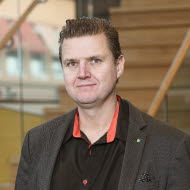Research to strengthen the capacity of the electricity grid and enable the green transition
The energy system faces major challenges as fossil fuels are replaced with solar and wind power. To ensure stable electricity supply, new solutions for storage, control and regulation are needed. This is what Elektrovation will develop – in collaboration with energy companies in Västernorrland.
Mid Sweden University's research centre STC runs the project, which is supported by the Swedish Agency for Economic and Regional Growth, Region Västernorrland and the municipalities of Sundsvall, Örnsköldsvik and Sollefteå. In total, the project will receive support of SEK 30 million.
"This is a necessary investment to be able to bring more renewable energy into the system without expanding the electricity grid too much – which is both expensive and takes time. With the right technology for control and regulation, we can instead use the electricity grid we have more efficiently," says Kent Bertilsson, professor of power electronics at the STC research centre and project manager for Elektrovation.
A concrete example is the electric car charging in the Birsta shopping area outside Sundsvall, where the capacity of the electricity grid only becomes a problem one day a year – the travel day before Christmas, when many people want to fast charge at the same time, which creates a temporary peak effect. One possible solution is to automatically reduce the charging speed at that moment, something that requires technology for intelligent control.
"It's about creating systems that can balance themselves by controlling between production and consumption. There is great potential to develop solutions that make it both cheaper and more stable for society," says Kent Bertilsson.
Industrial doctoral students at the energy companies
The project will start in September and includes three industrial doctoral students who will be placed directly in the energy companies' operations:
- In Örnsköldsvik, a doctoral student will work on a new district where access to electricity does not meet future needs. The focus is on how the electricity supply can be controlled and regulated over time to make optimal use of the electricity grid.
- In Sundsvall, a doctoral student will investigate how a common electricity grid can be created for the football stadium, the town hall and a parking garage with electric car charging. Here you want to be able to prioritize electricity consumption depending on the situation – for example, cut down on electric car charging when there is a match.
- In Sollefteåforsen, regulating power linked to hydropower will be analysed and developed.
"We don't develop this in a lab. Through the industrial doctoral students, research takes place in the operations, which provides both benefit and access to knowledge," says Kent Bertilsson.
New knowledge and close dialogue valuable
Anders Bergman, CEO of Sollefteåforsen, also sees great advantages in the collaboration. He emphasizes that the industrial doctoral student has contributed valuable expertise and created an important link to the research world.
"It is a great asset to have an industrial doctoral student on site. It gives us both new knowledge and a close dialogue with research. We will investigate how we can optimise so that the power plant can cost-effectively deliver support services to the electricity grid with a smaller energy storage," says Anders Bergman.
The project builds on a feasibility study in which researchers and energy companies in the region mapped challenges, networked and laid a foundation for collaboration. Now it's about testing and developing solutions together.
Reducing peak effects is crucial – they are the ones that drive up electricity prices. By levelling consumption and directing consumption to times when the supply is greater, both price and climate impact can be reduced.
"It will be cheaper for society if we can control and use electricity smarter. We also need to create new tools that make electricity enough for more people," says Kent Bertilsson.
Contact

